 Mankind has long ceased to wait for discoveries from its native planet. And there were no white spots on the maps, and the foot of man had already set foot everywhere. We are waiting for meetings with other civilizations, launching telescopes into orbit and sending radio signals to the boundaries of the solar system. Meanwhile, the Earth can still give us a lot of surprises.
Mankind has long ceased to wait for discoveries from its native planet. And there were no white spots on the maps, and the foot of man had already set foot everywhere. We are waiting for meetings with other civilizations, launching telescopes into orbit and sending radio signals to the boundaries of the solar system. Meanwhile, the Earth can still give us a lot of surprises.
Scientists regularly encounter biological species previously unknown to science. Today we publish Top-10 new species of plants and animals , found in various parts of the world. The data were collected in 2011 by the International Institute for the Study of Species of the University of Arizona( USA).
Contents:
- 10. Sazima tarantula( Pterinopeima sazimai)
- 9. Walking cactus( Diania cactiformis)
- 8. Millipede( Crurifarcimen vagans)
- 7. Nepalese autumn poppy( Meconopsis autumnalis)
- 6. Mushroom "Sponge Bob Square Pants"(Spongiforma squarepantsii)
- 5. Wasp parasite( Kollasmosoma)
- 4. Night orchid( Bulbophyllum nocturnum),
- 3. Devilish worm( Halicephalobus mephisto)
- 2. Bonaire banded box jelly, Tamoya ohboya
- 1Snub Nosed Monkey
10. Sazima Tarantula( Pterinopeima sazimai)
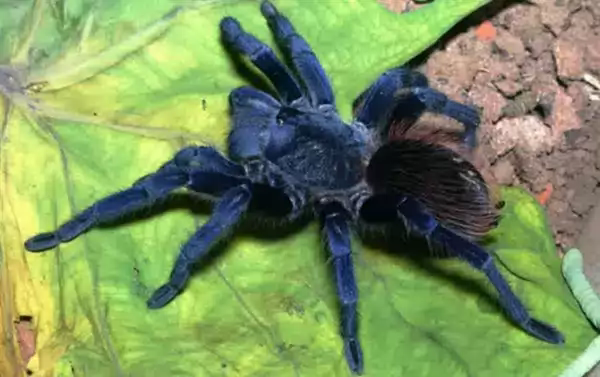 occurs on the Shapada-Diamantina mountain plateaulskom Bahia. For the first time these large spiders - tarantulas were discovered in the 1970s by the Brazilian zoologist Ivan Sazim, after whom they were named. A distinctive feature of the spider are the bright blue villi on the body and limbs.
occurs on the Shapada-Diamantina mountain plateaulskom Bahia. For the first time these large spiders - tarantulas were discovered in the 1970s by the Brazilian zoologist Ivan Sazim, after whom they were named. A distinctive feature of the spider are the bright blue villi on the body and limbs.
9. Walking cactus( Diania cactiformis)
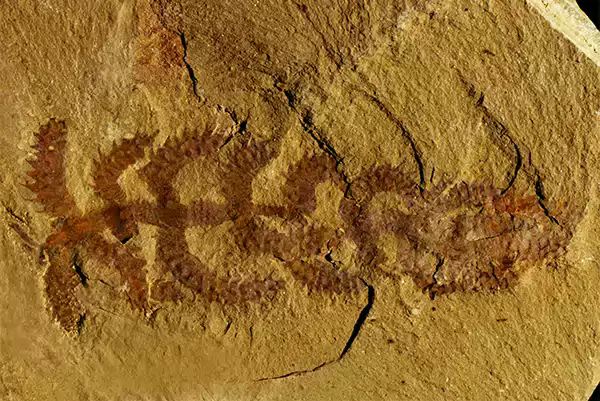 is not a new species of terrestrial flora, but a fossil find of archeologists, which got its name because of its similarity to a prickly plant. These invertebrates lived on Earth about 520 million years ago. They had a worm-like body and an impressive number of legs.
is not a new species of terrestrial flora, but a fossil find of archeologists, which got its name because of its similarity to a prickly plant. These invertebrates lived on Earth about 520 million years ago. They had a worm-like body and an impressive number of legs.
8. The centipede giant( Crurifarcimen vagans)
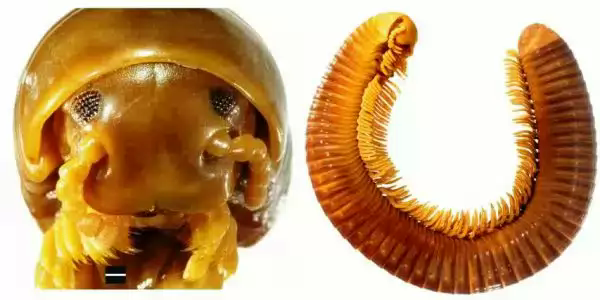 has a size of about 16 cm. The world's largest centipedes live in East Tanzania. The body diameter is about 1.5 cm, the body consists of 56 segments, each of which is equipped with a pair of legs.
has a size of about 16 cm. The world's largest centipedes live in East Tanzania. The body diameter is about 1.5 cm, the body consists of 56 segments, each of which is equipped with a pair of legs.
7. Nepalese Autumn Poppy( Meconopsis autumnalis)
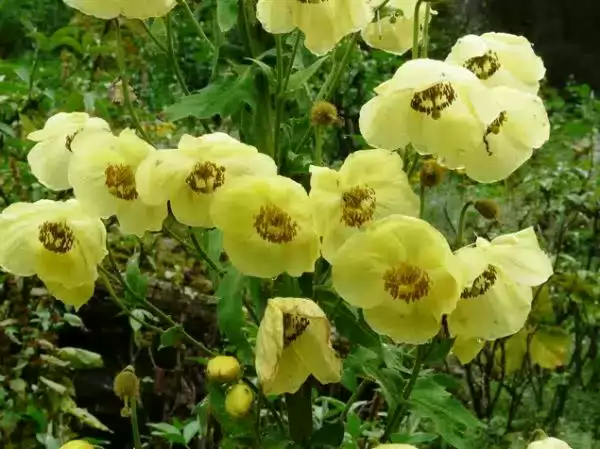 is a new plant found in Nepal at an altitude of 3,300 to 4,200 meters above sea level. The high-mountain flower has bright yellow petals and very adorns the slopes, the vegetation of which at such an altitude is quite poor. Most likely, the species has not been described to the present time only because at such an altitude there are rarely scientists-botanists.
is a new plant found in Nepal at an altitude of 3,300 to 4,200 meters above sea level. The high-mountain flower has bright yellow petals and very adorns the slopes, the vegetation of which at such an altitude is quite poor. Most likely, the species has not been described to the present time only because at such an altitude there are rarely scientists-botanists.
6. Mushroom "Sponge Bob Square Pants"( Spongiforma squarepantsii)
 was named after the hero of the famous cartoon. The fungus can really be squeezed like a sponge, after which it easily returns to its normal state. There is an amazing mushroom in the forests on the island of Borneo.
was named after the hero of the famous cartoon. The fungus can really be squeezed like a sponge, after which it easily returns to its normal state. There is an amazing mushroom in the forests on the island of Borneo.
5. Wasp-parasite( Kollasmosoma)
 searches for ants that become food for future offspring. And the speed of the process is amazing: to lay eggs the wasp spends only 1/20 of a second. There is a wasp-parasite in the vicinity of Madrid.
searches for ants that become food for future offspring. And the speed of the process is amazing: to lay eggs the wasp spends only 1/20 of a second. There is a wasp-parasite in the vicinity of Madrid.
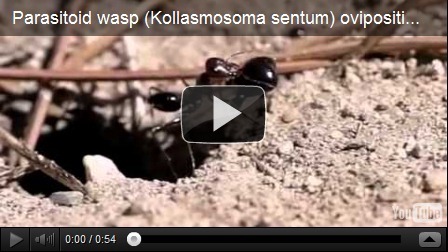
4. Night orchid( Bulbophyllum nocturnum),
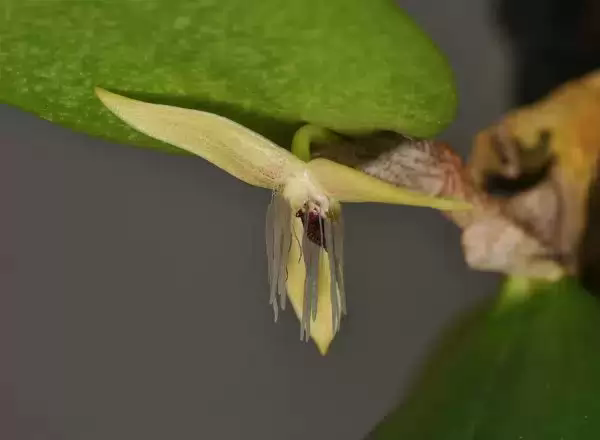 revealing its flowers exclusively at night. This plant lives in Papua New Guinea. It is the only one of 25 thousand species of orchids, preferring darkness. Scientists have yet to find out who is pollinating this mysterious orchid at night.
revealing its flowers exclusively at night. This plant lives in Papua New Guinea. It is the only one of 25 thousand species of orchids, preferring darkness. Scientists have yet to find out who is pollinating this mysterious orchid at night.
3. The Devilish Worm( Halicephalobus mephisto)
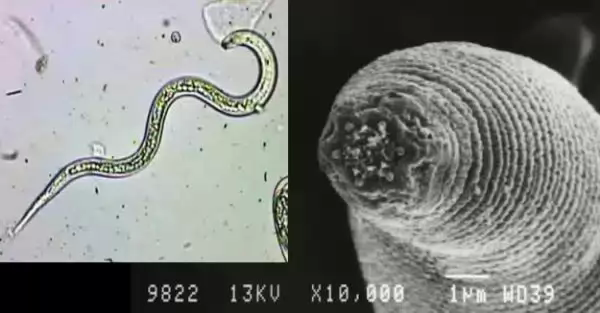 is one of the of the smallest animals on the planet .The length of the body of this new worm is about 0.5 mm. Found it at a depth of 1.3 km in a mine in South Africa. The devil's worm is recognized by as the most profound terrestrial multicellular organism on Earth .The living conditions for him are truly infernal - a stably high temperature and enormous pressure.
is one of the of the smallest animals on the planet .The length of the body of this new worm is about 0.5 mm. Found it at a depth of 1.3 km in a mine in South Africa. The devil's worm is recognized by as the most profound terrestrial multicellular organism on Earth .The living conditions for him are truly infernal - a stably high temperature and enormous pressure.
2. Bonaire boxed box jelly, Tamoya ohboya
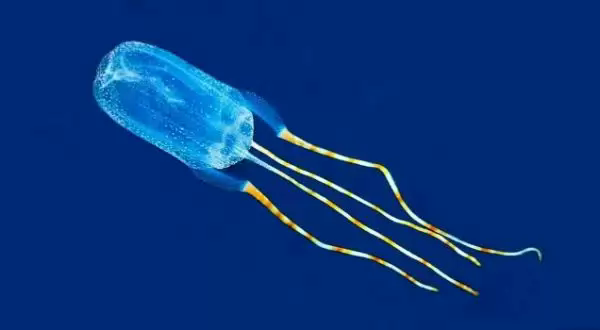 is an amazingly beautiful animal with long ribbon tails-tentacles. Its name was given to the jellyfish by the name of the Dutch island of Bonaire, located in the Caribbean Sea.
is an amazingly beautiful animal with long ribbon tails-tentacles. Its name was given to the jellyfish by the name of the Dutch island of Bonaire, located in the Caribbean Sea.

1. Snub Nosed Monkey
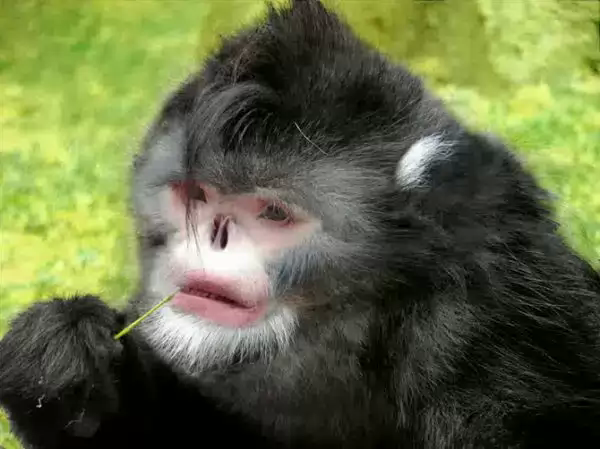 is a new species of primates discovered by scientists in North Myanmar in 2011.The first monkeys with prominent lips and wide, nostrils looking upwards were noticed by local hunters. The animal's body is covered with black fur, and a small white beard grows on the chin. Because of the surprising structure of the nose, monkeys sneeze during the rain from the moisture in the nostrils. The population is estimated at 260-330 individuals. Such a small number puts only the detected species on the verge of extinction, so it is a question of entering it into the Red Book.
is a new species of primates discovered by scientists in North Myanmar in 2011.The first monkeys with prominent lips and wide, nostrils looking upwards were noticed by local hunters. The animal's body is covered with black fur, and a small white beard grows on the chin. Because of the surprising structure of the nose, monkeys sneeze during the rain from the moisture in the nostrils. The population is estimated at 260-330 individuals. Such a small number puts only the detected species on the verge of extinction, so it is a question of entering it into the Red Book.



